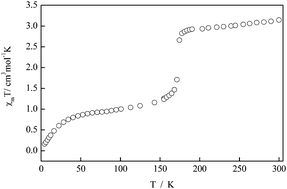In order to expand the few known examples of dinuclear iron(II) compounds displaying (weak) intradinuclear exchange coupling and spin-crossover on one or both of the iron(II) centres, various dinuclear compounds have been synthesised and assessed for their spin-crossover and exchange coupling behaviour. The key aim of the work was to prepare and structurally characterise ‘weakly linked’ and ‘covalently bridged’ systems incorporating bridging ligands such as alkyldinitriles (e.g.NC(CH2)4CN), bipyrimidine (bpym), dicyanamide (dca−), tricyanomethanide (tcm−), 3,6-bis(2-pyridyl)tetrazine (bptz) and 3,6-bis(2-pyridyl)2,5-dihydrotetrazine (H2bptz). The ‘end groups’, which complete the Fe(II)N6 chromophores, include tris(2-pyridylmethyl)amine (tpa), di(2-pyridylethyl)(2-pyridylmethyl)amine (tpa′), 3-(2-pyridyl)pyrazole (pypzH), 1,10-phenanthroline (1,10-phen), tris(pyrazolyl)methane (tpm) and NCX−
(X = S, Se). It was quite difficult to achieve the spin-crossover condition, many ligand combinations yielding high-spin/high-spin (HS–HS) Fe(II)Fe(II) spin states at all temperatures (300–2 K) with very weak antiferromagnetic coupling (J < −1 cm−1), two such being the crystallographically characterised [(dca)(tpm)Fe(μ1,5-dca)2Fe(tpm)(dca)], 5, and [(tpa′)Fe(μ1,5-tcm)2Fe(tpa′)](tcm)2(H2O)2, 6. In contrast, a strong field was created around the Fe(II) centres in [(tpa)Fe(μ-(NC(CH2)4CN))2Fe(tpa)](ClO4)4·NC(CH2)4CN, 1, and the Fe–N bond distances, at 173 K, reflected this. This weakly-linked dinitrile example showed a spin-crossover beginning above 300 K. ‘Half crossover’ examples, yielding HS–LS states below the spin transition, similar to those noted by Real and coworkers in some μ-bpym systems, were noted for [(1,10-phen)(NCS)2Fe(μ-bpym)Fe(NCS)2(1,10-phen)], 2, [(pypzH)(NCSe)2Fe(μ-bpym)Fe(NCSe)2(pypzH)], 4, and [(tpa)Fe(μ-H2bptz)Fe(tpa)](ClO4)4, 8. Interestingly, the μ-bptz analogue, 7, remained LS–LS at all temperatures with the start of a broad spin crossover evident above 300 K. No thermal hysteresis was evident in the spin transitions of these new dinuclear crossover species indicating a lack of intra- or interdinuclear cooperativity.


 Please wait while we load your content...
Please wait while we load your content...